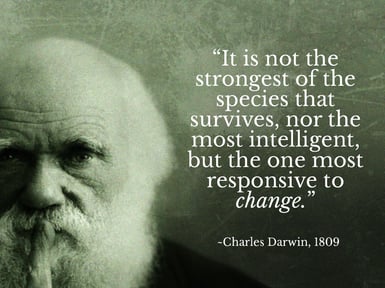Present Blog – IT Thought Leadership
Blog Present-IT thought leadership
Blog Present-IT thought leadership
IT thought leadership blog for CIOs and CTOs in Canada seeking resources to drive IT as a business contributor: hybrid cloud, infrastructure, managed services and security and IT recruitment.
 We have all been influenced by the following quote, most often attributed to Charles Darwin : "It is not the strongest of the species that survives, nor the most intelligent that survives. It is the one that is most adaptable to change."
We have all been influenced by the following quote, most often attributed to Charles Darwin : "It is not the strongest of the species that survives, nor the most intelligent that survives. It is the one that is most adaptable to change."
In today's reality, we could interpret it as: the companies that survive and thrive are those that know how to use data the most intelligently.
The definition of Big Data established by The 451 Group & Gartner gives a clear view of the new challenges companies face: ‘Big Data’ is the realization of competitive advantage by storing, processing and analyzing data that was previously ignored due to the cost and functional limitations of traditional data management technologies to handle its volume, velocity and variety.
90% of decisions made by corporate executives are NOT supported by data
According to a survey conducted by the Economist Intelligence Unit (EIU) in 2014, in 90% of cases, leaders make decisions based on their intuition. Only 10% of decisions are supported by concrete data and facts.
This finding may seem surprising at first, but is easily explained if one takes into account the following points:
-
Information at traditional companies is often found in different silos and leaders lack confidence in the sometimes contradictory reports they receive. There exists processes to extract, transform and load data (commonly called ETL), but they are long and tedious.
-
Business leaders have access to either descriptive (historical) or predictive (extrapolated from historical data) information but not real time, prescriptive information (recommendation of next steps or actions).
-
Existing information is too abundant and the volume is growing so fast that data can’t be processed with standard tools.
At the risk of being marginalized and disappearing, businesses today must develop the capabilities to quickly make informed decisions and implement them in a measured and consistent manner.
How to adapt and leverage data
To adapt, companies must be able to transform their internal and external data (stemming from social networks and the Internet of Things), into prescriptive information to anticipate change, react faster than their competitors and adapt their strategies.
1. Understanding the 3 inseparable dimensions of Big Data
It is necessary to distinguish between Business Intelligence (or BI), which refers to internal data generated by companies, and Big Data that is defined by three characteristics:
-
Volume : the total amount of collected data.
For example: transforming terabytes of Tweets created daily into an in- depth analysis of opinions on a product
-
Velocity : refers to the speed at which data is generated, captured, and processed.
For example: analyzing in real time high volumes of events to identify potential fraud.
-
Variety : relates to the form of structured or unstructured data (text, sensor data, sound, video, files, newspapers ...).
For example: Using the video stream from surveillance cameras to manage certain areas.
2. Big Data a priority for all lines of business
A fourth V is often associated to these three dimensions; knowing the Value. We know that there is a value associated with all the data which companies can access, whether internal and external, structured and unstructured.
And the question that is now asked by lines of business; marketing, finance and production is how to extract the value and apply it, in order to gain an advantage over competitors.
Conclusion
Among the business decisions that are most likely to help CMOs, CFOs, CTOs and all executives achieve their growth objectives, Gartner puts Big Data projects at the top of the list.
It is important to remember though that the value of Big Data is not so much the raw data itself, but it is the processing and analysis that brings out the strategic information. This, in turn, results in informed decisions and the implementation of concrete actions.
There is no doubt that companies that are today adopting Big Data shall be those best placed to thrive in the new economy.
Stay tuned for a series of articles on Big Data that will answer the following questions:
-
How to initiate a Big Data approach and what are the concrete benefits?
-
With what infrastructure (s) do you jump into Big Data?
About Blog
The right use of technology addresses business challenges and drives business growth in all areas of an enterprise. We hope this blog will offer insight into developing strategies and tactics to enable you to identify those key drivers of growth and keep pace with and anticipate the rapid technology change of today.
Posts by Topic
- IT infrastructure (116)
- IT security (92)
- IT Innovation (59)
- Trends (51)
- Cloud (47)
- Managed services (46)
- Mobility (38)
- Digital transformation (29)
- CIO/IT leaders (28)
- Events (28)
- News (23)
- Microsoft 365 (17)
- Security (17)
- IBM (16)
- Disaster recovery (DR) (14)
- High availability (12)
- Recruitment (12)
- Storage (12)
- Big Data (11)
- Collaboration (11)
- AI (9)
- Case study (9)
- Office 365 (9)
- BYOD (8)
- Customer Experience (8)
- Hybrid Cloud (7)
- Current events (6)
- SAP Hana (5)
- Business intelligence (BI) (4)
- Converged infrastructure (4)
- Convergence / Hyper-convergence (4)
- Virtualization (4)
- Copilot (3)
- Future of retail (2)
- Retail (2)
- trend (2)
- Backups (1)
- Beacon (1)
- Blog Migrations (1)
- Contests (1)
- Infrastructure TI (1)
- Innovation TI (1)
- IoT (1)
- MDM (1)
- Stockage (1)
- Virtualisation (1)
- blockchain (1)
- cio (1)
- replication (1)
- Étude de cas (1)


